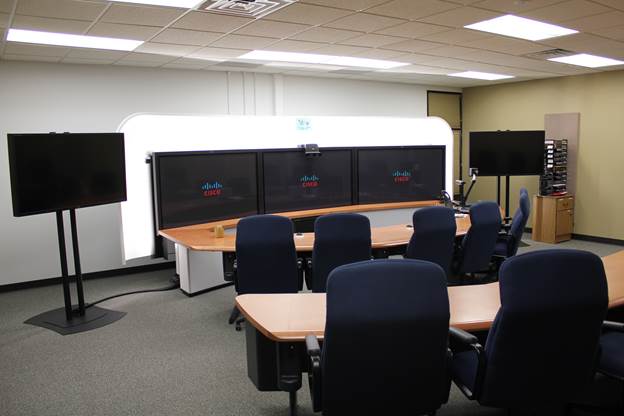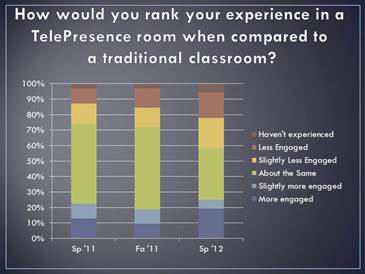Key Takeaways
- To offer additional courses at all of its locations without requiring students to drive to distant campuses, Moraine Park Technical College added three telepresence classrooms.
- Telepresence blends two classrooms at two different locations into one, and often students forget they're in separate locations.
- Telepresence is easier for instructors than using other video-conferencing rooms and also requires less IT support.
- Community groups and local nonprofits also use the telepresence rooms, expanding the college's reach and reputation among the community it exists to serve.
Pete Rettler is dean of Moraine Park Technical College's West Bend Campus.
Wisconsin's Moraine Park Technical College has three campuses, nearly 20,000 students, and a shared network of 150 full-time faculty members. Although that sounds typical, the college also lets students attend a wide variety of classes on the campus of their choice, without additional travel. It achieves this through high-end video conferencing, or telepresence, which offers students identical instruction to peers taking the class across town and lets professors teach both groups of students at once.
With an expanding curriculum and a need to offer more classes at more locations, Moraine Park saw advantages to adopting telepresence. Our challenge was to reduce the need for students to make the drive to another campus — typically more than 30 miles away — simply to attend a class we couldn't offer locally. This case study looks at how we resolved this challenge, while not only exceeding the needs and expectations of our students, faculty, and administration but also achieving an unanticipated increase in student engagement.
Telepresence as Innovation at Moraine Park
Moraine Park's journey toward telepresence began in the 1990s, when it installed interactive television and began offering interactive video conferencing (IVC). Remote students watched the class on a small TV screen; although it was innovative technology, it was also cumbersome and awkward. So, in 2000 we converted our IVC rooms to digital Internet Protocol rooms. To keep up with technological advancements, we later upgraded most of the IVC rooms to high-definition video conferencing rooms. Then, in 2010 the college implemented a Cisco telepresence room on each campus (figure 1). Faculty and students immediately embraced the technology for its ease of use — something Moraine Park had not experienced with earlier video conferencing solutions.
We chose telepresence because it blends two classrooms into one, seemingly eliminating the physical distance. After a few minutes in a telepresence class, the technology disappears and students forget they're in separate rooms. If a student on one campus drops a pen on the floor, a student at the other campus will bend down to pick it up — it's that real.

Figure 1. A telepresence classroom at Moraine Park
Status of Implementation
Our telepresence rooms are in high demand and booked 65 percent of the time. One reason is that telepresence rooms are easier for our instructors to use than other video-conferencing rooms. Getting a classroom online once involved multiple remotes and trial and error — even after training. In contrast, a telepresence classroom starts by pressing a button. After installing telepresence, some universities use special instructors to help with implementation, but we felt that was unnecessary. Our teachers have been able to operate the room almost immediately, without additional assistance. In fact, the only complaint we receive is that teachers must sit rather than stand or walk while giving a lecture. Otherwise, they say the room doesn't affect their pedagogy at all.
Our IT department is regularly called in to assist with the video conferencing room technology. In contrast, IT staff members realized the telepresence room was working well when they didn't hear from faculty and staff. Indeed, ongoing technical support is where we see our largest savings: it is significantly less expensive to support telepresence than to support our IVC rooms. The telepresence room has gone down just once since installation — after a data line was cut during a storm.
Student and Instructor Satisfaction
To demonstrate our return on investment (ROI), we use student surveys. Each semester, we ask students to indicate their engagement with face-to-face classes (no telepresence), telepresence classes, and online classes. Figure 2 shows the comparison between a telepresence room and a traditional classroom, including a recent survey of roughly 150 students from all three campuses, in which 19.4 percent of students said they were more engaged in a telepresence class than in a face-to-face class.

Figure 2. Student ratings of telepresence classes over a one-year period
When comparing their experience with telepresence to an online classroom, 34 percent of students said they were more engaged in the telepresence classroom. This is not surprising; Moraine Park has three telepresence rooms, two of which hold 14 students each, and one of which holds six, so a typical class is 20–25 students total. The rooms are laid out in concentric circles, so students are looking at each other rather than at the backs of the students in front of them. Each room is also equipped with a bidirectional speaker system that ensures every student is heard. It is almost impossible to hide in a telepresence classroom; as a result, faculty members say they are better able to judge student comprehension, and thus know when it's time to move on or spend more time on a topic.
Kim Olson, mechanical design instructor at Moraine Park, said he requests a telepresence room whenever possible. "You are able to see your students' faces and expressions and tell if they understand the material," said Olson. "I would even say telepresence is better than other classrooms because you can make sure students are engaged. In effect, no student is ever further than two rows away from you."
Olson teaches a class on geometric dimensioning and tolerancing that requires students to use complex symbols and formulas. According to Olson, it is critical for students in his course to bounce ideas off of one another. "I have my students at different campuses work together on group activities using telepresence during class," said Olson. "Often, they are learning things from each other when I'm not even presenting."
Expanding Opportunities
Telepresence has become a draw for Moraine Park, giving us a competitive edge. Our tour guides always take prospective students to the telepresence rooms as part of campus tours. The ability to offer the latest technology is enticing, especially for students pursuing a technical course of study. Students also see the advantage of taking more classes from their home campus, supported by telepresence.
Communities in our area benefit from telepresence because it lets residents pursue degrees without having to travel to schools in other cities. Moraine Park also makes telepresence rooms available to local community groups and nonprofits so they can conduct meetings at a distance. For example, local businesses have used the rooms to conduct meetings with people from Florida to Hong Kong.
One student used the telepresence room to complete a challenge from her dean: connect with someone in another nation to discuss her major. The student linked Moraine Park's culinary advisors with advisors from a culinary institute in Austria. To engage students hesitant about telepresence, Moraine Park holds events that give students and faculty the ability to experience the telepresence classroom without committing to a semester course. One such event is our Lunch 'n Learns. We playfully tout the session as "face-to-face, freaky real and awesome."
With telepresence, we like to think that we're not only offering a more appealing version of education, but actually improving it. As an example, we're currently working with four-year colleges to offer bachelors' degree completion courses through our telepresence classrooms.
Challenges and Resolutions
Although telepresence is increasingly more affordable, yearly maintenance alone is nearly $80,000, and Moraine Park's board of trustees and other stakeholders wanted solid reasoning for implementing it. In addition to providing a comprehensive financial plan, Moraine Park administrators took the board to another institution to experience telepresence firsthand. After the demonstration, the board committed to bringing telepresence to Moraine Park.
To determine our budget, we worked with our technology partner CDW-G. Because costs depend on both existing technology and the level of immersion an institution wants to achieve, no two colleges have the same telepresence budget. In our case, for example, we had updated the phone system a year before, which eliminated a standard expense.
Impact and Recommendations
I've been with Moraine Park Technical College for 17 years, currently serving as dean of Moraine Park Technical College's West Bend Campus, and I don't think technical colleges have ever been more highly regarded in Wisconsin. A student's $5,000 investment in a program can yield a $100,000 job. Although we consider telepresence an invaluable addition to our campuses, we do have recommendations for institutions considering the addition of a telepresence classroom.
First, we thoroughly discuss ROI upfront and recommend careful attention to project planning. To achieve the full experience of being in the same place together, telepresence rooms have specific requirements beyond technology installation. Cisco recommends having compatible room sizes, lighting, acoustics, power, HVAC, and even design. The remote room should mirror the room on the companion campuses; this ensures that the technology blends into the environment and that students feel like they're in a classroom, not a movie theater.
Whenever possible, institutions considering telepresence should also do the following:
- Demonstrate the technology to college stakeholders.
- Take advantage of planned remodeling to simultaneously install telepresence in classrooms.
- Install telepresence in the largest possible rooms; in our experience, students and faculty are eager to enroll in telepresence classes.
- Ensure that your campus infrastructure can support the technology. Allow the time and budget for necessary upgrades prior to installation.
- Track telepresence room usage and student engagement; both are useful tools for determining ROI.
- Take advantage of National LambdaRail to connect with other institutions.
Conclusions
Telepresence adoption in higher education will continue to grow because it offers both a high-quality experience and new opportunities for students. Currently, 39 percent of higher education students and 32 percent of higher education faculty report using telepresence in their classrooms.1 Moreover, 37 percent of higher education students and 28 percent of higher education faculty want more telepresence incorporated into classes as a learning tool. Moraine Park's own experience presents a compelling case study for adoption of telepresence in classrooms.
- CDW-G, Learn Now, Lecture Later, survey/report, CDW, 2012.
© 2013 Peter Rettler. The text of this EDUCAUSE Review Online article is licensed under the Creative Commons Attribution 3.0 license.
